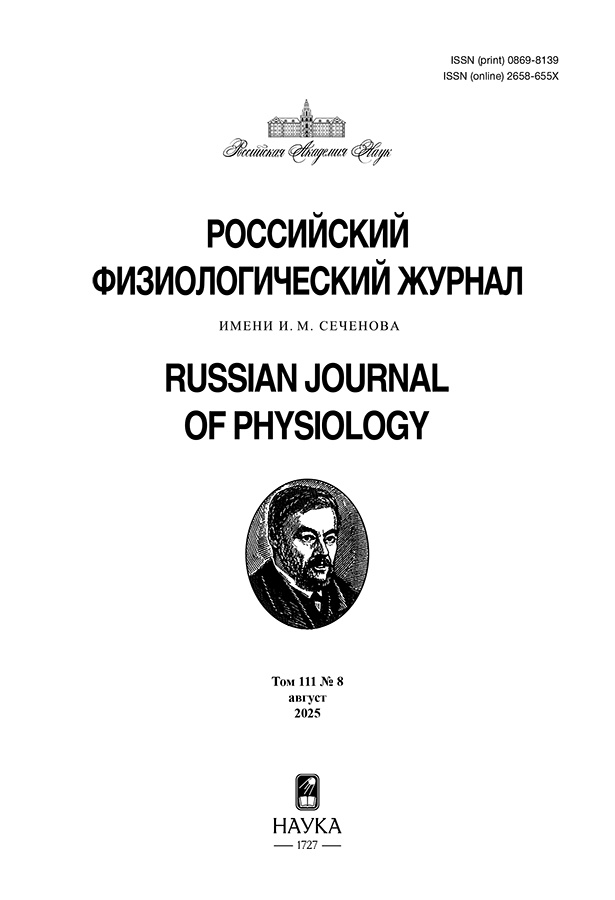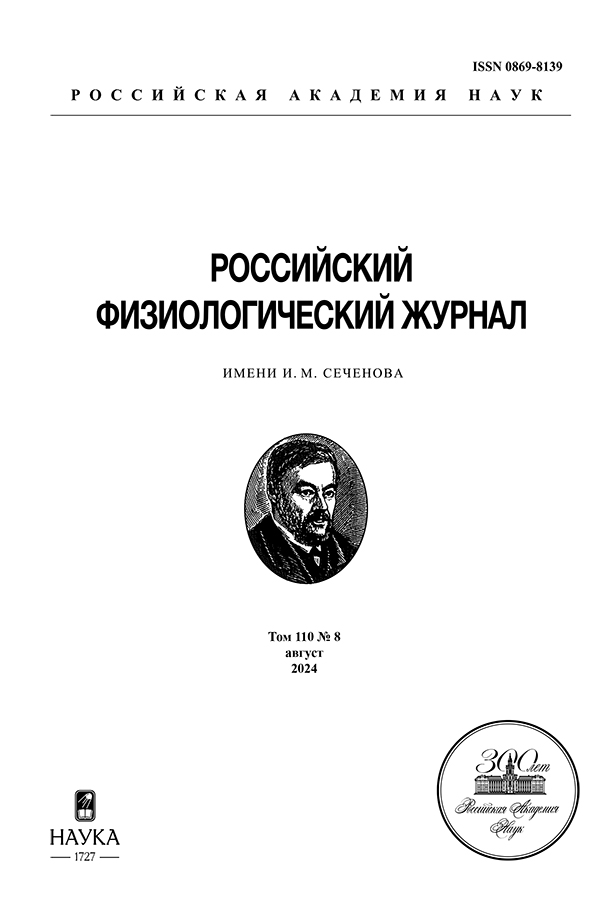Том 110, № 8 (2024)
ЭКСПЕРИМЕНТАЛЬНЫЕ СТАТЬИ
Динамика сенсомоторных ритмов ЭЭГ у детей с церебральным параличом при прохождении курса нейрореабилитации в зависимости от успешности представления ими движений
Аннотация
У 50 детей 7–15 лет обоего пола, страдающих детским церебральным параличом (ДЦП), проведен анализ изменений электроэнцефалограммы (ЭЭГ) в частотных диапазонах сенсомоторных мю- (8–13 Гц) и бета- (15–25 Гц) ритмов и особенностей восстановления двигательных функций в процессе курса нейрореабилитации из 10 сеансов с применением неинвазивного интерфейса «мозг – компьютер – экзоскелет кисти». ЭЭГ регистрировали в 32 отведениях в условиях покоя и кинестетического воображения движений разгибания кистей рук. В зависимости от успешности определения программой-классификатором воображаемых состояний по паттерну ЭЭГ дети были разделены на две группы – с высокой и низкой успешностью представления движений. У детей исследованных групп при прохождении курса нейрореабилитации выявлены отличия в характере изменений амплитуды ЭЭГ в частотных диапазонах указанных ритмов. При представлении движений правой руки межгрупповые различия для мю-ритма достигали уровня статистической значимости в сагиттальных отведениях лобно-центральных и теменных областей неокортекса, для бета-ритма – в сагиттальном лобно-центральном отведении. У детей группы с низкой успешностью в указанных областях на последнем сеансе курса по сравнению с первым наблюдался рост амплитуды сенсомоторных ритмов, свидетельствующий о развитии торможения в лобно-теменной двигательной сети. У детей группы с высокой успешностью в этих областях амплитуды мю- и бета-ритма к последнему сеансу не менялись, т. е. степень синхронизации/десинхронизации сенсомоторных ритмов при представлении движений в процессе курса нейрореабилитации оставалась стабильной. Пациенты, состояния которых классификатор определял более точно, достигли более высоких показателей реабилитации двигательной сферы. Результаты исследования важны для уточнения мозговых механизмов восстановления двигательных функций у пациентов с ДЦП под влиянием курса нейрореабилитации.
 1223-1237
1223-1237


Интраназальное введение белка GRP78 (HSPA5) противодействует гибели нейронов в голубом пятне в модели хронической депривации сна у крыс
Аннотация
Хроническое недосыпание (сон менее 6 ч в сутки) в связи с производственной необходимостью и снижением качества сна является эндемическим заболеванием в современном обществе. Хроническое недосыпание вызывает серьезные нейроповеденческие нарушения, сопряженные с необратимыми нейродегенеративными изменениями в головном мозге. Поиск фармакологических агентов способных снизить риск развития нейродегенерации в результате хронической потери сна является актуальной задачей биомедицины. Интраназальное введение глюкозо-регулируемого белка теплового шока 78 кДа (GRP78) оказывает нейропротективный эффект в модели болезни Паркинсона у крыс. Нейропротективный потенциал интраназально введенного GRP78 при хроническом недосыпании ранее не исследовался. Задача исследования – выяснить, способно ли профилактическое интраназальное введение GRP78 ослабить и/или остановить процесс нейродегенерации в голубом пятне в модели хронического ограничения сна (ОС) у крыс. Исследование проведено на 6-месячных самцах крыс популяции Вистар. Для депривации сна был применен валидизированный метод качающейся платформы в режиме: 3 ч лишения сна и 1 ч покоя непрерывно в течение 5 суток. Рекомбинантный белок GRP78 человека вводили интраназально за два дня до начала ОС и в течение 5 суток ОС. Клеточно-молекулярные изменения в голубом пятне при ОС и при введении GRP78 исследовались с помощью иммуногистохимии и вестерн-блоттинга. Показано, что хроническое ОС приводит к гибели 30% норадренергических нейронов в голубом пятне, которое было сопряжено с повышением уровней активированных каспаз-3, 9. Это свидетельствует о развитии апоптоза по митохондриальному пути. Признаков реактивного микроглиоза не обнаружено в модели хронического ОС у крыс. Мы продемонстрировали, что интраназально введенный GRP78 проникает и накапливается в норадренергических нейронах голубого пятна, это противодействует гибели нейронов по пути апоптоза. Полученные данные позволяют считать GRP78 потенциальным нейропротекторным средством для профилактики патологических последствий хронического недосыпания.
 1238-1252
1238-1252


Применение лактоферрина для профилактики и восстановления изменений костной ткани у крыс Wistar в условиях опорной разгрузки
Аннотация
Изучено влияние гравитационной разгрузки (антиортостатического вывешивания) и последующего восстановления на минеральную плотность и механические свойства бедренной и большеберцовой костей крыс Wistar при пероральном приеме биотехнологического аналога лактоферрина человека (200 мг/кг), выделенного из молока коз-продуцентов. Минеральную плотность костей определяли методом двухэнергетической рентгеновской абсорбциометрии, прочность и жесткость – исследованиями костей на трехточечный изгиб. Показано, что гравитационная разгрузка в течение 21 суток приводила к снижению минеральной плотности большеберцовой и бедренной костей. Применение лактоферрина значимо не повлияло на минеральную плотность и проекционную площадь исследуемых костей. Статистически значимых различий между экспериментальными группами по значению механической жесткости обнаружено не было, но при этом у животных после реадаптации предел прочности был значимо выше в группах, получавших лактоферрин. Полученные результаты могут свидетельствовать о перспективности применения препаратов лактоферрина в качестве средств профилактики для поддержания прочностных свойств. В то же время сохранение минеральной плотности костной ткани в дефицит-стимулирующих условиях требует рассмотрения альтернативных дозировок и способов доставки препарата.
 1253-1263
1253-1263


Влияние консервации на изменение объема клеток эндотелия роговицы в среде с высокой концентрацией калия
Аннотация
Проведено экспериментальное исследование воздействия высокой (100 мM) концентрации калия в среде на объем клеток эндотелия роговицы человека в зависимости от времени холодовой консервации донорского препарата. Приведены результаты исследования единичных образцов и значения, полученные на объединенном материале фрагментов донорских образцов после содержания препаратов в консервационной среде при 4 ℃ в течение 4 и 10 дней. Увеличение времени холодовой консервации препаратов привело к снижению процента клеток, способных набухать в среде с повышенным содержанием ионов калия (94.3% и 56.8% после 4 и 10 дней соответственно). Исследование клеток, способных к набуханию, показало, что увеличение времени их холодовой консервации привело к снижению средней величины (M ± SEM) коэффициента набухания клеток в среде с высокой концентрацией калия с 1.055 ± 0.001 до 1.014 ± 0.001 после 4 и 10 дней соответственно. Высокую степень достоверности различия этих значений (p-value = 2E-76) показали с помощью t-критерия Стьюдента для независимых выборок.
По результатам исследования высказывается предположение, что величины набухания клеток эндотелия в калиевой среде могут служить показателями способности клеток к восстановлению электрогенного транспорта. Делается заключение, что исследование реакции клеток эндотелия роговицы на повышение концентрации ионов калия в среде может давать информацию для прогноза функциональности трансплантата.
 1264-1272
1264-1272













